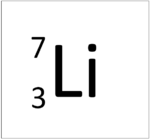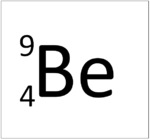Difference between revisions of "Proton"
(→About Protons) |
|||
| Line 36: | Line 36: | ||
{| border="1" style="border-collapse:collapse" | {| border="1" style="border-collapse:collapse" | ||
| − | | style="height:20px; width: | + | | style="height:20px; width:100px; text-align:center;"|'''[[Subatomic Particle]]''' |
| − | | style="height:20px; width: | + | | style="height:20px; width:100px; text-align:center;"|'''[[Quark]]-composition''' |
| − | | style="height:20px; width: | + | | style="height:20px; width:100px; text-align:center;"|[[Electrical Charge|'''Charge''']]/[[Elementary Charge|e]] |
| − | | style="height:20px; width: | + | | style="height:20px; width:100px; text-align:center;"|'''[[Strangeness]]''' |
| − | | style="height:20px; width: | + | | style="height:20px; width:100px; text-align:center;"|'''[[Conservation of Baryon Number|Baryon Number]]''' |
| − | | style="height:20px; width: | + | | style="height:20px; width:100px; text-align:center;"|'''[[Conservation of Lepton Number|Lepton Number]]''' |
|- | |- | ||
| − | | style="height:20px; width: | + | | style="height:20px; width:100px; text-align:center;"| |
[[Proton]] | [[Proton]] | ||
| − | | style="height:20px; width: | + | | style="height:20px; width:100px; text-align:center;"|<math>uud</math> |
| − | | style="height:20px; width: | + | | style="height:20px; width:100px; text-align:center;"|<math>q=+1</math> |
| − | | style="height:20px; width: | + | | style="height:20px; width:100px; text-align:center;"|<math>S=0</math> |
| − | | style="height:20px; width: | + | | style="height:20px; width:100px; text-align:center;"|<math>b=+1</math> |
| − | | style="height:20px; width: | + | | style="height:20px; width:100px; text-align:center;"|<math>l=0</math> |
|- | |- | ||
| − | | style="height:20px; width: | + | | style="height:20px; width:100px; text-align:center;"| |
[[Antiproton]] | [[Antiproton]] | ||
| − | | style="height:20px; width: | + | | style="height:20px; width:100px; text-align:center;"|<math>\bar{u}\bar{u}\bar{d}</math> |
| − | | style="height:20px; width: | + | | style="height:20px; width:100px; text-align:center;"|<math>q=-1</math> |
| − | | style="height:20px; width: | + | | style="height:20px; width:100px; text-align:center;"|<math>S=0</math> |
| − | | style="height:20px; width: | + | | style="height:20px; width:100px; text-align:center;"|<math>b=-1</math> |
| − | | style="height:20px; width: | + | | style="height:20px; width:100px; text-align:center;"|<math>l=0</math> |
|} | |} | ||
Revision as of 17:38, 18 July 2019
Key Stage 4
Meaning
The Proton is a positively charged particle found in the nucleus of an atom.
About Protons
- Protons are a type of nucleon.
- Protons have a relative atomic charge of +1 and a relative atomic mass of 1.
| Hydrogen | Helium | Lithium | Beryllium |
| This atom has an Atomic Number (Z) of 1 therefore it contains 1 proton. | This atom has an Atomic Number (Z) of 2 therefore it contains 2 proton. | This atom has an Atomic Number (Z) of 3 therefore it contains 3 proton. | This atom has an Atomic Number (Z) of 4 therefore it contains 4 proton. |
Key Stage 5
Meaning
A proton (p) is a baryon made from 2 up-quarks and 1 down-quark.
About Protons
- A proton is one of two baryons found in the atomic nucleus.
- Protons have a charge of 1.60x10-19 Coulombs (the elementary charge) and a mass of 1.67x10-27kg.
- A proton is the most stable hadron with a half life longer than the age of the Universe.
| Subatomic Particle | Quark-composition | Charge/e | Strangeness | Baryon Number | Lepton Number |
| \(uud\) | \(q=+1\) | \(S=0\) | \(b=+1\) | \(l=0\) | |
| \(\bar{u}\bar{u}\bar{d}\) | \(q=-1\) | \(S=0\) | \(b=-1\) | \(l=0\) |



